The Intel Broadwell Desktop Review: Core i7-5775C and Core i5-5675C Tested (Part 1)
by Ian Cutress on June 2, 2015 7:45 AM ESTProfessional Performance: Windows
Agisoft Photoscan – 2D to 3D Image Manipulation: link
Agisoft Photoscan creates 3D models from 2D images, a process which is very computationally expensive. The algorithm is split into four distinct phases, and different phases of the model reconstruction require either fast memory, fast IPC, more cores, or even OpenCL compute devices to hand. Agisoft supplied us with a special version of the software to script the process, where we take 50 images of a stately home and convert it into a medium quality model. This benchmark typically takes around 15-20 minutes on a high end PC on the CPU alone, with GPUs reducing the time.
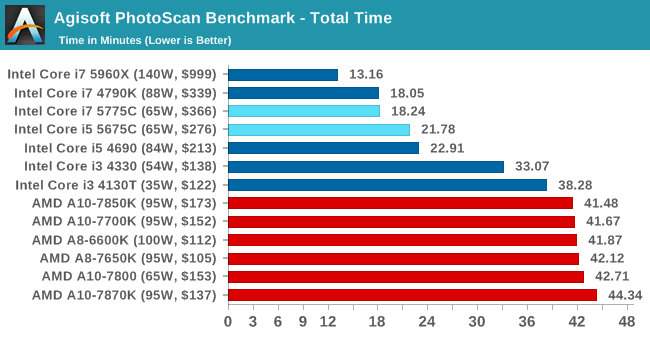
The presence of Crystal Well had a small effect on Photoscan, occurring mostly in the second phase of the calculation which is the one that also has an option to enable the GPU, indicating that memory bandwidth is an potential limitation in that segment.
Cinebench R15
Cinebench is a benchmark based around Cinema 4D, and is fairly well known among enthusiasts for stressing the CPU for a provided workload. Results are given as a score, where higher is better.
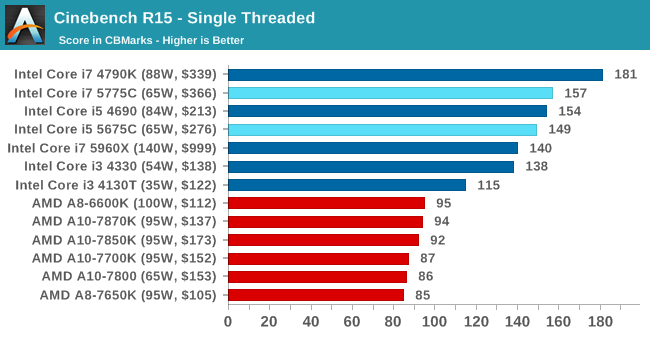
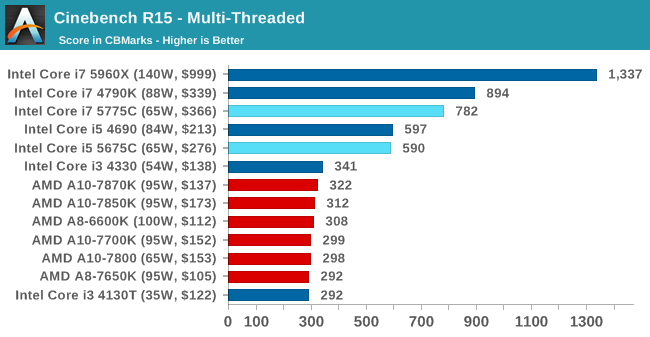
Cinebench is a historically CPU-limited benchmark, and the results show this again here. The fact that the 3.6GHz Broadwell-based i5-5675C performs so closely to the 3.9GHz Haswell-based i5-4690 is a promising sign here, as it means that despite being a mere "tick" in Intel's development efforts, there are tangible IPC increases on the desktop from Broadwell.
HandBrake v0.9.9: link
For HandBrake, we take two videos (a 2h20 640x266 DVD rip and a 10min double UHD 3840x4320 animation short) and convert them to x264 format in an MP4 container. Results are given in terms of the frames per second processed, and HandBrake uses as many threads as possible.
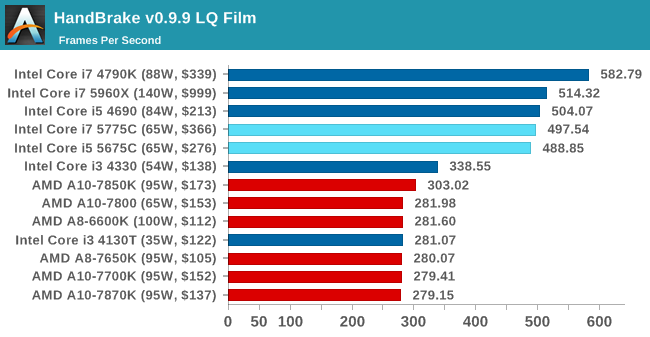

While no obvious improvement was seen in the low quality conversion, the double UHD conversion put the i7 above what was otherwise expected.
Hybrid x265
Hybrid is a new benchmark, where we take a 4K 1500 frame video and convert it into an x265 format without audio. Results are given in frames per second.
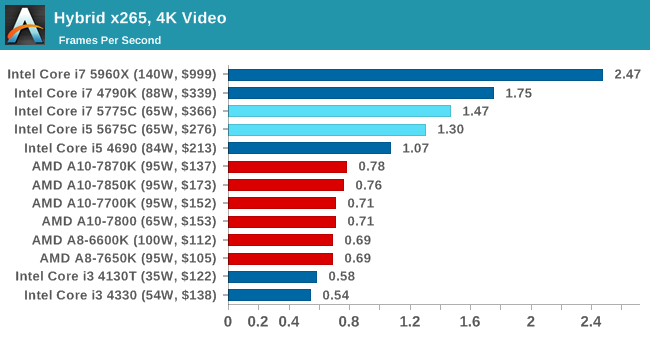
Unlike the Handbrake H.264 tests, the Hybrid x265 tests show a clear uptick in performance on the Broadwell processors. It is not fast enough to catch the i7-4790K and its 4.4GHz turbo clockspeed, but we see the i5-5675C shoot well past the i5-4690 despite the clockspeed deficit. Whether this is due to Broadwell architecture enhancements, Crystal Well acting as an L4 cache, or a combination of the two is difficult to determine, but the end result is substantial.










196 Comments
View All Comments
Shadowmaster625 - Tuesday, June 2, 2015 - link
Wow so anyone who buys one of these chips is spending half their money on a useless GPU that cant even beat a lowly R7 250. That is $120 to $180 totally wasted on GPU, which occupies half the die. Talk about a massive intel tax. What happens if intel only offer a K version that contains half the die wasted by this useless GPU? How many people are going to just suck it up and buy it even though half the chip will never be used because they will be running a real graphics card?TEAMSWITCHER - Tuesday, June 2, 2015 - link
These chips really only make sense for high end laptops like the 2015 MacBook Pro - which ironically doesn't use them. It boggles my mind that Intel is shipping so many transistors that go completely unused. It's the antithesis of Moore's Law - Intel silicon is HALF-USELESS.PubFiction - Wednesday, July 1, 2015 - link
That's because intel only cares about mobile now, this stuff isn't made for us its hacked to work for desktop users this stuff is all about mobile. Personally I deal with largely because I am just happy that people who buy stuff like macbooks can now actually have a chance of running boot camp and playing games. In the mobile work igpus have always been a big part of the scene. Also the better intel does with integrated graphics the more they are able to kill AMD/NVidia which is what they really want to do, slowly and steadily eat the bottom end of the GPU market out from under them. It used to be that ANY discreet graphics on a laptop was WAYYYYY better than integrated. But after intels 2nd gen core series the bottom X1XX and X2XX gpus seemed to not make any sense, and intel has been getting better to the point now that X4XXX gpus are starting to not make sense. This screws graphics makers into only being able to sell higher end X5XX + GPUs and they destroys their bread and butter money.bill.rookard - Tuesday, June 2, 2015 - link
As much as I hate to say it, I agree. While their new iGPU is beating AMDs iGPU, the place where such iGPUs make sense is in small HTPC scenarios most of all (apart from budget gaming laptops which have a completely different thermal restriction). The kicker is though that the pricing is far too high for even being considered for what amounts to a media playback machine. It's thermally too hot for a laptop scenario.If they had paired up the iGPU with a G3258 CPU core set and the Crystalwell DRAM, and priced it near AMD's offerings, THAT would be a very compelling product.
Refuge - Tuesday, June 2, 2015 - link
I'd buy that.extide - Tuesday, June 2, 2015 - link
Uhhh, maybe you need your eyes checked, but it is beating the R7 240 in all except one of the benchmarks...MikhailT - Tuesday, June 2, 2015 - link
Dude, go re-read the graphs, Intel is beating R7 in almost all benchmarks.Namisecond - Wednesday, June 3, 2015 - link
Actually, the GPU takes up over 60% of the die space on the first chips, there is a 2nd piece of silicon comprising the EDRAM that take up a not-so-insignificant piece of real estate on the chip.The situation with AMD APUs are similar, about 40-45% of their die space is GPU. When they go HBM, they will in a similar situation to Intel, and they'll need to charge much higher price to make up for the tech.
If you want lowest cost/value for CPU, get a Pentium, particularly the anniversary edition. They're cheap (I can get them for about $50) You can overclock the shit out of them and their IGPU only takes up about 40% of their die space. If you need more CPU power in the Socket 1150 format, get a Xeon E3 which has no IGPU...they are cheaper than Core I7, but they cost more than core I5.
der - Tuesday, June 2, 2015 - link
Awesome stuff! Killer chipset!der - Tuesday, June 2, 2015 - link
50th comment!